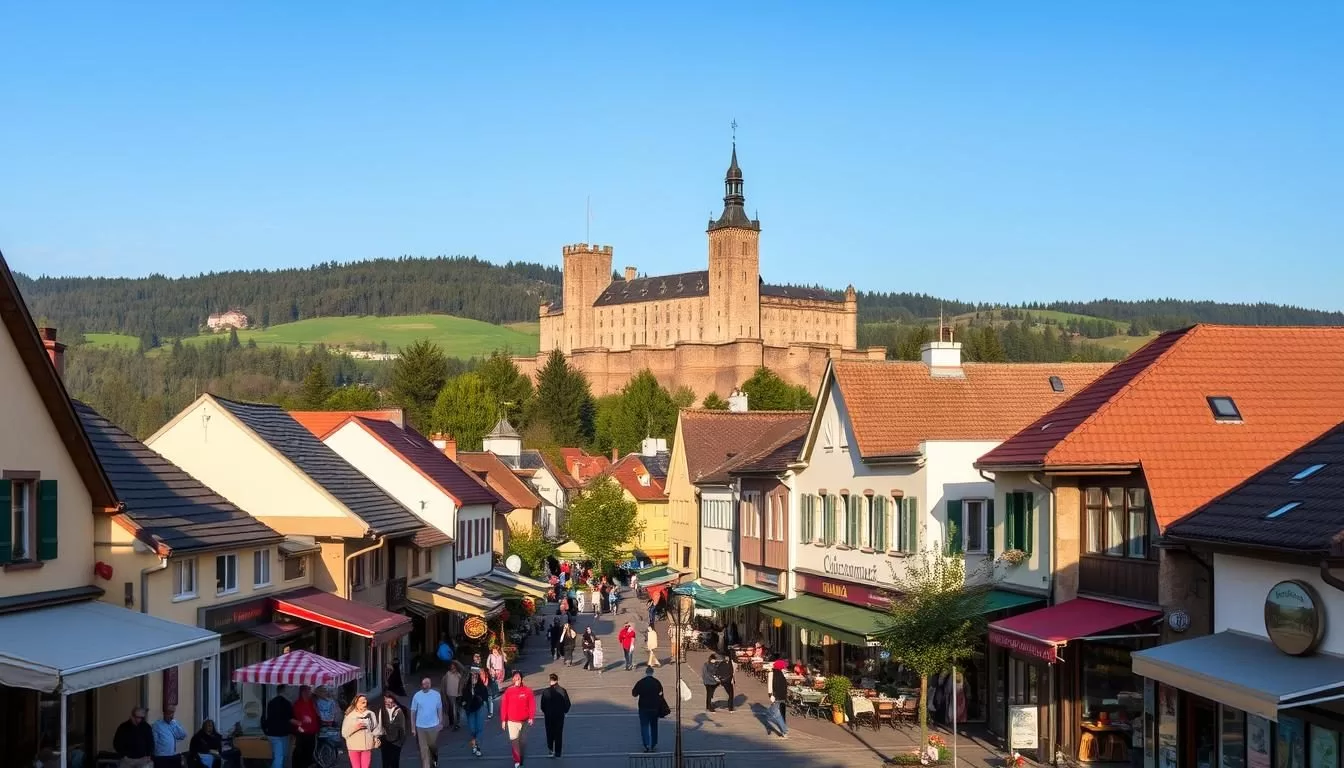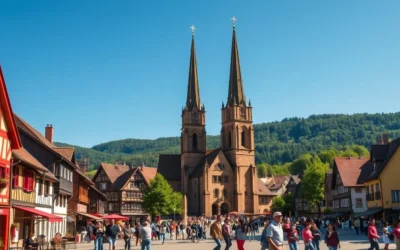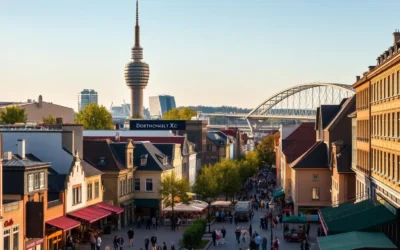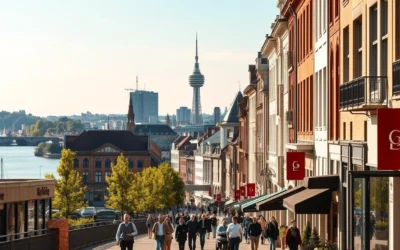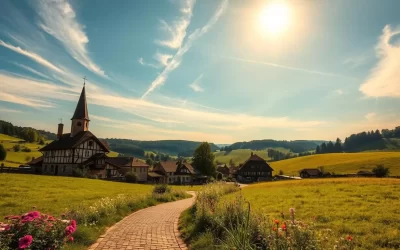Because population lists are outdated even before they can be published, the following estimates have been rounded for easier comparison.
1. Berlin – 3,755,000
Capital city; Germany’s largest metropolis and political heart.
2. Hamburg – 1,892,000
Major port city and trade hub in the north.
3. Munich – 1,512,000
Bavarian capital known for culture, tech, and Oktoberfest.
4. Cologne – 1,085,000
Historic Rhine city with a towering cathedral.
5. Frankfurt am Main – 773,000
Financial center and major transport hub.
6. Stuttgart – 633,000
Automotive capital and cultural center in southwest Germany.
7. Düsseldorf – 629,000
Fashion and media hub on the Rhine.
8. Leipzig – 616,000
Growing city with arts, music, and history.
9. Dortmund – 593,000
Industrial and sporting center in the Ruhr.
10. Essen – 585,000
Former coal-steel powerhouse turned cultural city.
11. Bremen – 569,000
Historic Hanseatic port city.
12. Dresden – 563,000
Baroque architecture and cultural treasures.
13. Hanover – 545,000
Peaceful fair city with green spaces.
14. Nuremberg – 523,000
Medieval architecture and Christmas markets.
15. Duisburg – 502,000
Rhine port city, formerly industrial heartland.
16. Bochum – 366,000
Education and cultural city in the Ruhr Valley.
17. Wuppertal – 359,000
City known for its suspended monorail and hilly terrain.
18. Bielefeld – 338,000
Regional economic and service center.
19. Bonn – 336,000
Former capital and cultural city on the Rhine.
20. Münster – 321,000
Cycling capital and university town.
21. Mannheim – 316,000
Planned city and economic hub at Rhine-Neckar junction.
22. Karlsruhe – 309,000
Judicial capital with a fan-shaped layout.
23. Augsburg – 301,000
Historic city with Renaissance influence.
24. Wiesbaden – 283,000
Spa town and Hesse’s elegant capital.
25. Mönchengladbach – 268,000
Green, industrial city near Cologne.
26. Gelsenkirchen – 263,000
Football and mining heritage in the Ruhr.
27. Aachen – 252,000
Charlemagne’s historic and academic center.
28. Braunschweig – 252,000
Medieval architecture with a dense cultural scene.
29. Chemnitz – 249,000
City reinventing itself post-industrial era.
30. Kiel – 248,000
Northern seaport and sailing destination.
31. Halle – 242,000
Baroque town with a rich musical history.
32. Magdeburg – 239,000
Capitol of Saxony-Anhalt with riverside charm.
33. Freiburg – 236,000
Sunny university city on Black Forest’s edge.
34. Krefeld – 228,000
Textile-industry city just outside Düsseldorf.
35. Mainz – 221,000
Historic wine city on the Rhine.
36. Lübeck – 218,000
Hanseatic port famed for Gothic architecture and marzipan.
37. Erfurt – 215,000
Thuringian capital with a well-preserved old town.
38. Oberhausen – 211,000
Transformation city in the Ruhr.
39. Rostock – 210,000
Baltic port and gateway to the Hanseatic past.
40. Kassel – 204,000
City of arts and the world’s largest document archive.
41. Hagen – 190,000
Industrial city with cultural offerings in the Ruhr.
42. Potsdam – 186,000
Prussian palaces and cinematic landscapes near Berlin.
43. Saarbrücken – 182,000
Franco-German cultural crossroads near the Saar border.
44. Hamm – 181,000
Logistics and transport hub in NRW.
45. Ludwigshafen – 174,000
Chemical industry giant opposite Mannheim.
46. Oldenburg – 173,000
Cultural and administrative center in northwest Germany.
47. Mülheim an der Ruhr – 172,000
City of media and industry on the Ruhr.
48. Osnabrück – 167,000
Peaceful historic town with strong trade legacy.
49. Leverkusen – 166,000
Pharmaceutical center and football club headquarters.
50. Heidelberg – 162,000
Romantic university city nestled in the Neckar valley.
51. Darmstadt – 162,000
Science and technology hub near Frankfurt.
52. Solingen – 161,000
‘City of Blades’ famed for cutlery and steelwork.
53. Regensburg – 157,000
UNESCO medieval center on the Danube.
54. Herne – 157,000
Dense urban area in the Ruhr with cultural ties.
55. Paderborn – 155,000
Historic university and tech town in eastern NRW.
56. Neuss – 154,000
Rhine-neighbor with Roman roots opposite Düsseldorf.
57. Ingolstadt – 141,000
Automotive powerhouse and historic city on the Danube.
58. Offenbach – 134,000
Adjacent to Frankfurt with creative energy.
59. Fürth – 131,000
Historic twin city next to Nuremberg.
60. Ulm – 129,000
Birthplace of the Danube and its tallest church tower.
61. Heilbronn – 128,000
Vibrant wine and tech city on the Neckar.
62. Pforzheim – 128,000
Goldsmith city near the northern Black Forest.
63. Würzburg – 128,000
Baroque splendor and Franconian wine region.
64. Wolfsburg – 126,000
Home of Volkswagen and Autostadt.
65. Göttingen – 119,000
Renowned university city in Lower Saxony.
66. Bottrop – 118,000
Coal-roots city moving toward culture and services.
67. Reutlingen – 118,000
Textile center at the edge of the Swabian Jura.
68. Erlangen – 117,000
Medical and university town near Nuremberg.
69. Bremerhaven – 115,000
Ocean town with maritime heritage.
70. Koblenz – 115,000
City at the Rhine–Moselle confluence with strong history.
71. Bergisch Gladbach – 113,000
Green suburb near Cologne.
72. Remscheid – 113,000
Industrial city in the Berg region.
73. Trier – 112,000
Germany’s oldest city with Roman heritage.
74. Recklinghausen – 112,000
Cultural city in the Ruhr region.
75. Jena – 111,000
Science and optics hub in central Germany.
76. Moers – 105,000
Historic city on the lower Rhine.
77. Salzgitter – 105,000
Major steel production center in Lower Saxony.
78. Siegen – 103,000
University and industrial town in Siegerland.
79. Gütersloh – 102,000
Corporate headquarters and green city in NRW.
80. Hildesheim – 102,000
UNESCO cathedral city with ancient roots.
81. Hanau – 101,000
Brothers Grimm birthplace and trade hub near Frankfurt.
82. Kaiserslautern – 101,000
US base nearby and university city in Palatinate.
83. Cottbus – 100,000
Brandenburg art and industrial center.
84. Schwerin – 99,000
Capital of Mecklenburg-Vorpommern with a fairy-tale palace.
85. Witten – 96,000
Cultural and manufacturing city in the Ruhr.
86. Esslingen am Neckar – 95,000
Medieval town near Stuttgart.
87. Ludwigsburg – 94,000
Baroque palace town north of Stuttgart.
88. Gießen – 94,000
University town in Hesse.
89. Gera – 94,000
Thuringian city with historic architecture.
90. Düren – 93,000
Historic city in NRW between Cologne and Aachen.
91. Tübingen – 93,000
Quaint university town in Baden-Württemberg.
92. Flensburg – 93,000
Border city with Denmark and harbor town in the north.
93. Iserlohn – 93,000
Iron-rich town in the Sauerland.
94. Villingen-Schwenningen – 88,000
Twin-town in the Black Forest area.
95. Ratingen – 87,000
Suburb of Düsseldorf with economic strength.
96. Zwickau – 87,000
Automotive and musical heritage in Saxony.
97. Lünen – 87,000
Mining town turned residential near Dortmund.
98. Konstanz – 86,000
Lake city on the Swiss border with medieval charm.
99. Worms – 85,000
Historic city on the Rhine with imperial past.
100. Marl – 84,000
Post-industrial city in the Ruhr.
The above is subject to change.
Check back often to TRAVEL.COM for the latest travel tips and deals.
